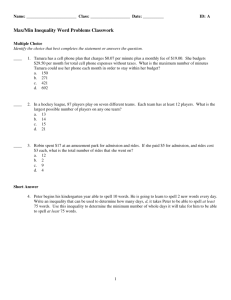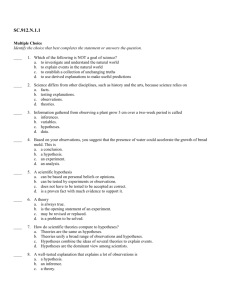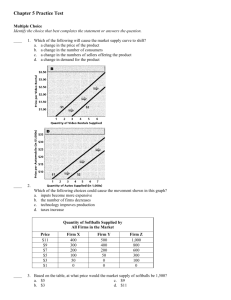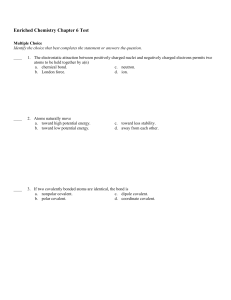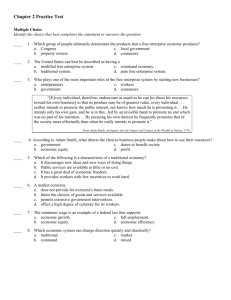Word Version
advertisement
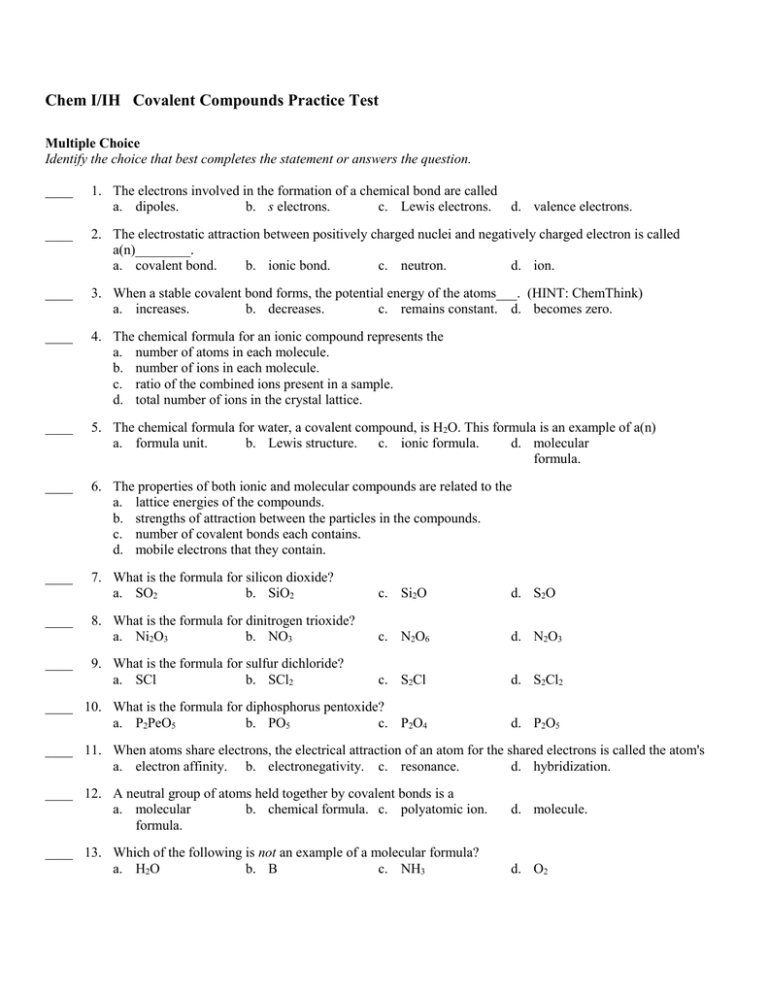
Chem I/IH Covalent Compounds Practice Test Multiple Choice Identify the choice that best completes the statement or answers the question. ____ 1. The electrons involved in the formation of a chemical bond are called a. dipoles. b. s electrons. c. Lewis electrons. d. valence electrons. ____ 2. The electrostatic attraction between positively charged nuclei and negatively charged electron is called a(n)________. a. covalent bond. b. ionic bond. c. neutron. d. ion. ____ 3. When a stable covalent bond forms, the potential energy of the atoms___. (HINT: ChemThink) a. increases. b. decreases. c. remains constant. d. becomes zero. ____ 4. The chemical formula for an ionic compound represents the a. number of atoms in each molecule. b. number of ions in each molecule. c. ratio of the combined ions present in a sample. d. total number of ions in the crystal lattice. ____ 5. The chemical formula for water, a covalent compound, is H2O. This formula is an example of a(n) a. formula unit. b. Lewis structure. c. ionic formula. d. molecular formula. ____ 6. The properties of both ionic and molecular compounds are related to the a. lattice energies of the compounds. b. strengths of attraction between the particles in the compounds. c. number of covalent bonds each contains. d. mobile electrons that they contain. ____ 7. What is the formula for silicon dioxide? a. SO2 b. SiO2 c. Si2O d. S2O 8. What is the formula for dinitrogen trioxide? a. Ni2O3 b. NO3 c. N2O6 d. N2O3 9. What is the formula for sulfur dichloride? a. SCl b. SCl2 c. S2Cl d. S2Cl2 ____ 10. What is the formula for diphosphorus pentoxide? a. P2PeO5 b. PO5 c. P2O4 d. P2O5 ____ ____ ____ 11. When atoms share electrons, the electrical attraction of an atom for the shared electrons is called the atom's a. electron affinity. b. electronegativity. c. resonance. d. hybridization. ____ 12. A neutral group of atoms held together by covalent bonds is a a. molecular b. chemical formula. c. polyatomic ion. formula. ____ 13. Which of the following is not an example of a molecular formula? a. H2O b. B c. NH3 d. molecule. d. O2 ____ 14. The electron configuration of nitrogen is 1s2 2s2 2p3. How many more electrons does nitrogen need to satisfy the octet rule? a. 1 b. 3 c. 5 d. 8 ____ 15. What group of elements satisfies the octet rule without forming compounds? a. halogen c. alkali metal b. noble gas d. alkaline-earth metal ____ 16. Multiple covalent bonds may occur in atoms that contain carbon, nitrogen, or a. chlorine. b. hydrogen. c. oxygen. d. helium. ____ 17. The chemical formula for a covalent compound represents the a. number of atoms in each molecule. c. ratio of the combined atoms present in a sample. b. number of ions in each molecule. d. total number of atoms in the crystal lattice. ____ 18. The proper name for HClO is a. hydrochloric acid b. hypochlorous acid c. chlorous acid d. chloric acid ____ 19. The proper formula for acetic acid is_____. a. HC2H3O2 b. H2C2H3O2 c. H4As d. HAs ____ 20. The proper name for O2 is_____. a. dioxide b. dioxygen c. oxygen d. oxide Short Answer 21. Why do most atoms form chemical bonds? 22. Differentiate between an ionic compound and a molecular compound. 23. What type of compound cannot be represented by a molecular formula? Explain your answer. 24. Write the correct name for the following covalent compounds. a. S2Cl2 d. H2SO3 b. CF4 e. I2 c. C4H10 25. Write the correct formula for the following covalent compounds. a. oxalic acid d. hydrosulfuric acid b. nitrogen e. hexane c. diphosphorus pentoxide Chem I/IH Covalent Compounds Practice Test Answer Section MULTIPLE CHOICE 1. ANS: OBJ: 2. ANS: OBJ: 3. ANS: OBJ: 4. ANS: OBJ: 5. ANS: OBJ: 6. ANS: OBJ: 7. ANS: OBJ: 8. ANS: OBJ: 9. ANS: OBJ: 10. ANS: OBJ: 11. ANS: OBJ: 12. ANS: OBJ: 13. ANS: OBJ: 14. ANS: OBJ: 15. ANS: OBJ: 16. ANS: OBJ: 17. ANS: 18. ANS: 19. ANS: 20. ANS: D 1 A 1 B 2 C 1 D 1 B 4 B 5 D 5 B 5 D 5 B 3 D 1 B 1 B 3 B 3 C 5 A B A C PTS: STA: PTS: STA: PTS: STA: PTS: STA: PTS: STA: PTS: STA: PTS: 1 DIF: I SC.A.1.4.5 1 DIF: I SC.A.1.4.5 1 DIF: I SC.A.1.4.2 | SC.C.2.4.5 1 DIF: I SC.A.2.4.2 1 DIF: II SC.A.2.4.2 1 DIF: I SC.A.1.4.5 1 DIF: II REF: 1 REF: 1 REF: 2 REF: 3 REF: 3 REF: 3 REF: 1 PTS: 1 DIF: II REF: 1 PTS: 1 DIF: II REF: 1 PTS: 1 DIF: II REF: 1 PTS: STA: PTS: STA: PTS: STA: PTS: DIF: I REF: 1 DIF: I REF: 2 DIF: II REF: 2 DIF: II REF: 2 PTS: 1 DIF: I REF: 2 PTS: STA: PTS: PTS: PTS: PTS: DIF: II REF: 2 1 SC.A.1.4.5 1 SC.A.2.4.2 1 SC.A.2.4.2 1 1 SC.A.1.4.5 1 1 1 1 SHORT ANSWER 21. ANS: Atoms form chemical bonds to establish a more-stable arrangement. As independent particles, they are at high potential energy. By bonding, they decrease their potential energy, thus becoming more stable. PTS: 1 DIF: II REF: 1 OBJ: 2 STA: SC.A.1.4.5 22. ANS: Atoms in a molecular compound share electrons to achieve stability. Atoms in an ionic compound gain or lose electrons to form ions, which combine so that the number of positive and negative charges is equal. PTS: 1 DIF: II REF: 3 OBJ: 1 STA: SC.A.2.4.2 23. ANS: An ionic compound cannot be represented by a molecular formula because it is not made up of molecules. PTS: 1 STA: SC.A.2.4.2 24. ANS: DIF: II a. disulfur dichloride b. carbon tetrafluoride c.butane d. sulfurous acid e. iodine PTS: 1 25. ANS: a. H2C2O4 b. N2 c. P2O5 d. H2S e. C6H14 PTS: 1 REF: 1 OBJ: 1


